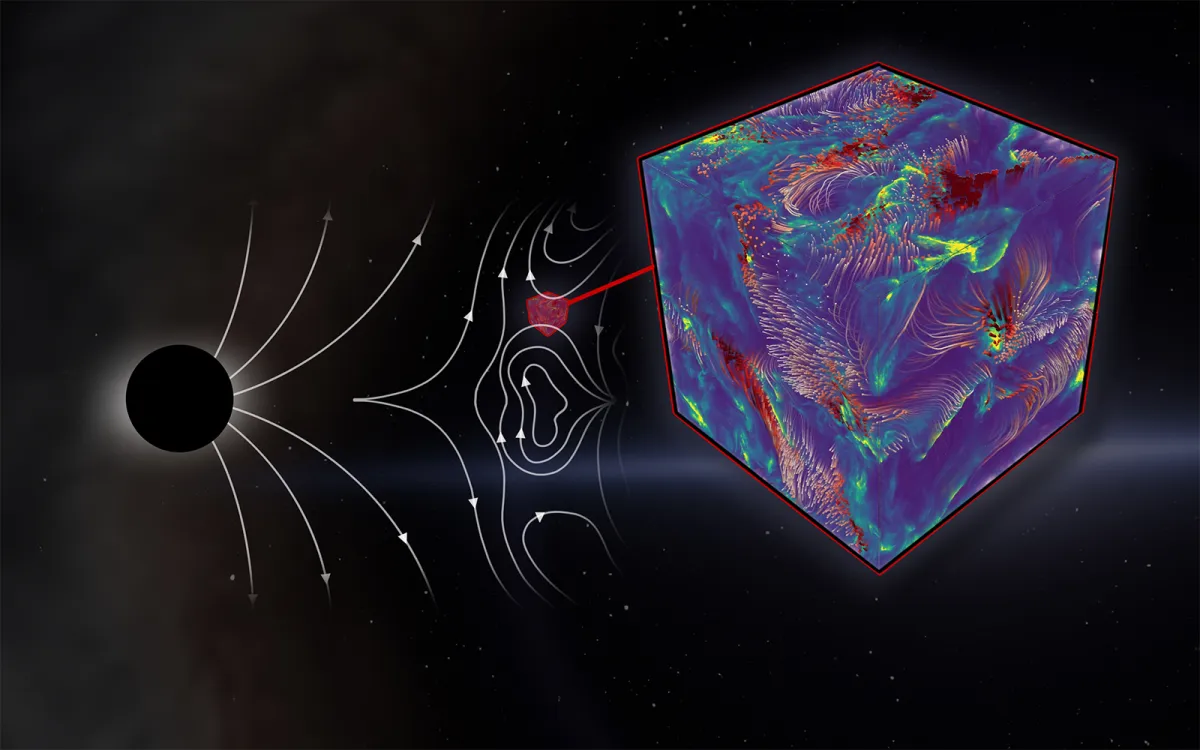After attempting to explain the X-ray radiation coming from the environs of the black hole since the 1970s, researchers from the University of Helsinki have now succeeded in their endeavor. The chaotic motions of turbulent plasma gas and magnetic fields interact to produce the radiation. The research was published in the journal Nature Communications.
 Visualization shows how the turbulent plasma moves in the magnetized accretion disk corona. Image Credit: Jani Närhi
Visualization shows how the turbulent plasma moves in the magnetized accretion disk corona. Image Credit: Jani Närhi
University of Helsinki researchers explored the interplay between radiation, plasma, and magnetic fields around black holes using intricate supercomputer simulations. They discovered that the magnetic fields' chaotic movements, or turbulence, heated and radiated the local plasma.
Focus on the X-Ray Radiation From Accretion Disks
When a massive star falls into a mass concentration so dense that light cannot escape its gravitational pull, the result is a black hole. For this reason, black holes cannot be directly witnessed; instead, their influence on the environment can only be inferred indirectly.
A binary star system is formed when two black holes observed together have a companion star. The companion star's matter slowly spirals into the black hole as the two objects in the binary system orbit one another. This slowly moving gas stream, which is a visible, bright source of X-rays, frequently forms an accretion disk around the black hole.
Since the 1970s, attempts have been made to mimic the radiation from the accretion flows surrounding the black holes. At the time, it was already believed that X-rays were produced by the interaction of magnetic fields with nearby gas, much like solar flares cause the Sun's surrounding area to heat via magnetic activity.
The flares in the accretion disks of black holes are like extreme versions of solar flares.
Joonas Nättilä, Associate Professor, University of Helsinki
Nättilä also heads the Computational Plasma Astrophysics research group at the University of Helsinki, which specializes in modeling precisely this kind of extreme plasma.
Radiation–Plasma Interaction
The simulations showed that even quantum effects become significant for the plasma dynamics because of the extreme turbulence surrounding the black holes.
The local X-ray radiation can transform into electrons and positrons in the modeled mixture of electron-positron plasma and photons, which can annihilate back into radiation when they come into contact.
Nättilä explains how antiparticles like electrons and positrons typically do not occur in the same location. However, even this is made possible by the highly energetic environments surrounding black holes. Generally speaking, radiation and plasma do not interact. However, photons around black holes are so energetic that plasma depends on their interactions.
In everyday life, such quantum phenomena where matter suddenly appears in place of extremely bright light are, of course, not seen, but near black holes, they become crucial. It took us years to investigate and add to the simulations all quantum phenomena occurring in nature, but ultimately, it was worth it.
Joonas Nättilä, Associate Professor, University of Helsinki
An Accurate Picture of the Origins of Radiation
The research proved that turbulent plasma naturally produces the type of X-ray radiation from the accretion disks. Depending on the external radiation field, the simulation allowed scientists to observe for the first time that the plasma around black holes can exist in two different equilibrium states: opaque and hot in one condition and transparent and cold in another.
The X-ray observations of black hole accretion disks show exactly the same kind of variation between the so-called soft and hard states.
Joonas Nättilä, Associate Professor, University of Helsinki
The study's simulation is the first model of plasma physics to incorporate all of the significant quantum interactions between radiation and plasma. The research is a component of a larger effort led by Nättilä that attempts to comprehend the interactions between radiation and plasma. The project is financed by a €2.2 million Starting Grant from the European Research Council.
Journal Reference:
Nättilä. J., et al. (2024) Radiative plasma simulations of black hole accretion flow coronae in the hard and soft states. Nature Communications. doi.org/10.1038/s41467-024-51257-1.